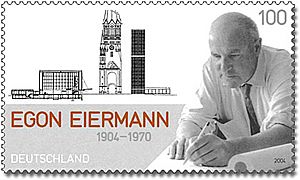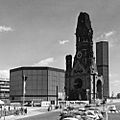Egon Eiermann facts for kids

Egon Eiermann (born September 29, 1904 – died July 20, 1970) was one of Germany's most important architects in the mid-1900s. He also designed furniture. From 1947, he taught architecture as a professor at the Technical University of Karlsruhe.
Contents
Biography
Egon Eiermann was born in Neuendorf bei Potsdam, which is now part of Babelsberg, Potsdam. His father was a locomotive engineer. Egon finished high school and then studied architecture at the Technical University of Berlin. From 1925 to 1928, he learned from a famous architect named Hans Poelzig.
After finishing his studies in 1928, he started working in construction. From 1931 to 1945, he worked as an independent architect in Berlin. At first, he designed homes. Before World War II, he shared an office with another architect, Fritz Jaenecke. During the difficult time of the Nazi era, he mostly designed buildings for factories.
In 1945, he moved to Buchen in West Germany. From 1946 to 1965, he had an office with Robert Hilgers. In 1948, their office moved to Karlsruhe. In 1947, he began teaching at the Technische Hochschule Karlsruhe. There, he worked on new ways to build with steel frames. Some of his students became famous architects too.
In 1950, he traveled to the United States. There, he met other well-known architects like Walter Gropius and Ludwig Mies van der Rohe. In 1967, Eiermann was in charge of the judges for the design competition for the Olympic Park in Munich.
Eiermann was married twice and had two children. He passed away in Baden-Baden at the age of 65 and is buried in the Buchen Cemetery.
Works
Egon Eiermann's buildings were very important during the time Germany was being rebuilt after the war. His industrial buildings, often made with steel frames, became examples for others. These buildings looked clear, welcoming, and well-organized.
He was a functionalist architect, meaning his designs focused on how the building would be used. Some of his most famous works include:
- The textile mill in Blumberg (1951).
- The West German building at the Brussels World's Fair (1958).
- The Embassy of Germany, Washington, D.C. (1958–1964).
- The tall building called Langer Eugen for the German Parliament in Bonn (1965–1969).
- The IBM-Germany Headquarters in Stuttgart (1967–1972).
- The Olivetti building in Frankfurt (1968–1972).
His most famous work is the new church at the site of the Kaiser Wilhelm Memorial Church in Berlin (1959–1963).
Eiermann also designed the sets for the 1926 film The Pink Diamond.
Some other important buildings he designed include:
- A power station in Berlin-Steglitz (1929–1930).
- Residential homes in Berlin (1931–1937).
- Factory buildings in Berlin and Apolda (1938–1941).
- An administration building for Ciba AG (1948–1950).
- A handkerchief weaving mill (1949–1950).
- The experimental power plant for the Technical University, Karlsruhe (1951–1956).
- St. Matthew Church in Pforzheim (1953).
- The Burda Moden publishing house (1953–1954).
- The Head office of Neckermann Versand KG in Frankfurt (1958–1961).
- His own house in Baden-Baden (1959–1962).
Design
From 1949, Eiermann started working with a company in Esslingen am Neckar to create furniture. He designed chairs and tables that could be mass-produced and were very practical.
Some of his furniture designs include:
- The SE 68 tubular steel chair (1950).
- The E 10 wicker chair (1952).
- The SE 18 wooden folding chair (1952–1953).
- The Eiermann 1 table frame (1953).
- The SE 121 Church seat (1960–1961).
Awards
Egon Eiermann received many awards for his architectural work:
- 1962: Berlin Art Prize
- 1965: An honorary doctorate from the Technical University of Berlin
- 1965: Grand State Prize for Architecture of the State of North Rhine-Westphalia
- 1968: Grand Prize of the Association of German Architects
- 1968: Grand Federal Cross of Merit
- 1969: Hugo Häring Prize
- 1970: Order Pour le Mérite for Science and Arts
In 1997, the Egon Eiermann Society was started in Karlsruhe to honor his work. In 2004, the German postal service even put his picture on a special stamp. A street in Karlsruhe was named Egon-Eiermann-Allee in 2009. One of the lecture halls at the Karlsruhe Institute of Technology is also named after him. There is even an international architecture competition called the Egon Eiermann Award.
Memberships
Eiermann was a member of several important groups:
- 1926: He helped start the "Group of Young Architects."
- 1931: He became a member of the Association of German Architects.
- 1931: He joined the Deutscher Werkbund, a group for design and crafts.
- 1951: He was a founding member of the German Design Council.
- 1955: He joined the Academy of Arts, Berlin (West) for architecture.
- 1960: He became an honorary member of the Central Association of Austrian Architects.
- 1962: He was part of the planning council for new buildings for the German government in Bonn.
- 1963: He became an honorary member of the Royal Institute of British Architects.
Images for kids
See also
 In Spanish: Egon Eiermann para niños
In Spanish: Egon Eiermann para niños






